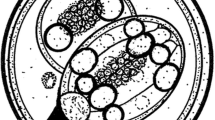Summary
Eimeria cyclopei n.sp. is described from the silky anteater, Cyclopes didactylus, from Pará State, north Brazil. Undifferentiated oocysts, passed in the faeces, complete sporulation in seven days at 26 to 28°C. Oocysts are ellipsoidal to sub-spherical, with a mean size of 28.1 × 23.6 μm: the wall is ∼1.5 to 2.0 μm thick, apparently with an outer thin, colourless membrane and two inner, thicker, striated and yellowish layers. There is no micropyle, oocyst residuum or polar body. The mean measurements of sporocysts are 19.0 × 9.0 μm, and they are slightly asymmetrical, elongate pear-shape, with a plug-shaped Steida body projecting beyond the end of the sporocyst. Sporozoites are as long as or longer than the sporocysts: The sporocyst residuum is scattered between sporozoites in younger specimens and becomes condensed into rounded mass in older ones. The endogenous stages occur in the epithelial cells of the ileum, on the lumenal side of the host-cell nucleus. Uninucleate meront, microgamont and macrogamont precursors are recognizable morphologically. Mature meronts are ∼ 20.0 × 15.7 μm some produce 12 to 20 merozoites which are ∼ 8.7 × 2.0 μm, and others 10 to 26 merozoites which are ∼ 11.4 × 2.0 to 15.0 × 3.0 μm. Mature microgamonts which are ∼27.5 × 24.1 μm, produce from 150 to 170 microgametes of ∼7.1 × 1.0 μm: microgametes have two flagella of unequal length. Mature macrogamonts are ∼ 28.4 × 24.5 μm Eimeria choloepi n.sp. is recorded from the two-toed sloth, Choloepus didactylus, from the same area of Brazil. Undifferentiated oocysts, passed in the faeces, complete sporulation in 23 days at 26 to 28°C. Oocysts with a mean size of 23.0 × 20.3 μm, have a wall ∼2.0 to 2.5 μm thick which is composed of two thick, yellowish and striated outer layers and a delicate, colourless inner one. There is no micropyle, oocyst residuum or polar granule. Mature sporocysts with a mean size of 11.3 × 7.1 μm, are ellipsoidal to egg-shaped and have a poorly developed Steida body. The sporocyst residuum is composed of a small number of large globules: The sporozoites are longer than the sporocyst and strongly recurved. The endogenous stages occur in epithelial cells of the ileum, on the lumenal side of the host-cell nucleus. Dimorphic meronts produce 8 to 18 merozoites which are either ∼13.0 × 2.0 μm or ∼13.0 × 3.0 μm. Microgamonts produce 50 to 80 microgametes of ∼8.0 × 1.0 μm. Mature macrogamonts are ∼18.3 × 17.9 μm. ac]19820212
Similar content being viewed by others
References
Carini A. (1933) Sur deux nouvelles Eimeria rencontrées dans l'intestin d'un jeune tatou. Annales de Parasitologie humaine et comparée, 11, 469–471.
daCunha A.M. & Muniz J. (1928) Sur un nouveau sporozoaire, parasite du tatou. Comptes rendus des Séances de la Sociéte de Biologie, 98, 624–627.
Hammond D.M. (1973) Life cycles and development of coccidia. In: The Coccidia. D.M.Hammond & P.L.Long (Editors). Baltimore: University Park Press, and London: Butterworths, p. 66.
Lainson R. (1959) Atoxoplasma Garnham, 1950, as a synonym for Lankesterella Labbé, 1899. Its life cycle in the English sparrow (Passer domesticus domesticus, Linn.). Journal of Protozoology, 6, 360–371.
Lainson R. (1968) Parasitological studies in British Honduras III.-Some coccidial parasites of mammals. Annals of tropical Medicine and Parasitology, 62, 252–259.
Pellérdy L.P. (1965) Coccidia and coccidiosis. Akadémiai Kiadó (Publishing House of the Hungarian Academy of Sciences), Budapest, 312 pp.
Rastegaieff E.F. (1930) Zur Frage über Coccidien wilder Tiere. Archiv für Protistenkunde, 71, 377–404.
Author information
Authors and Affiliations
Rights and permissions
About this article
Cite this article
Lainson, R., Shaw, J.J. Coccidia of Brazilian edentates: Eimeria cyclopei n.sp. from the silky anteater, Cyclopes didactylus (Linn.) and Eimeria choloepi n.sp. from the two-toed sloth, Choloepus didactylus (Linn.). Syst Parasitol 4, 269–278 (1982). https://doi.org/10.1007/BF00009629
Accepted:
Issue Date:
DOI: https://doi.org/10.1007/BF00009629




